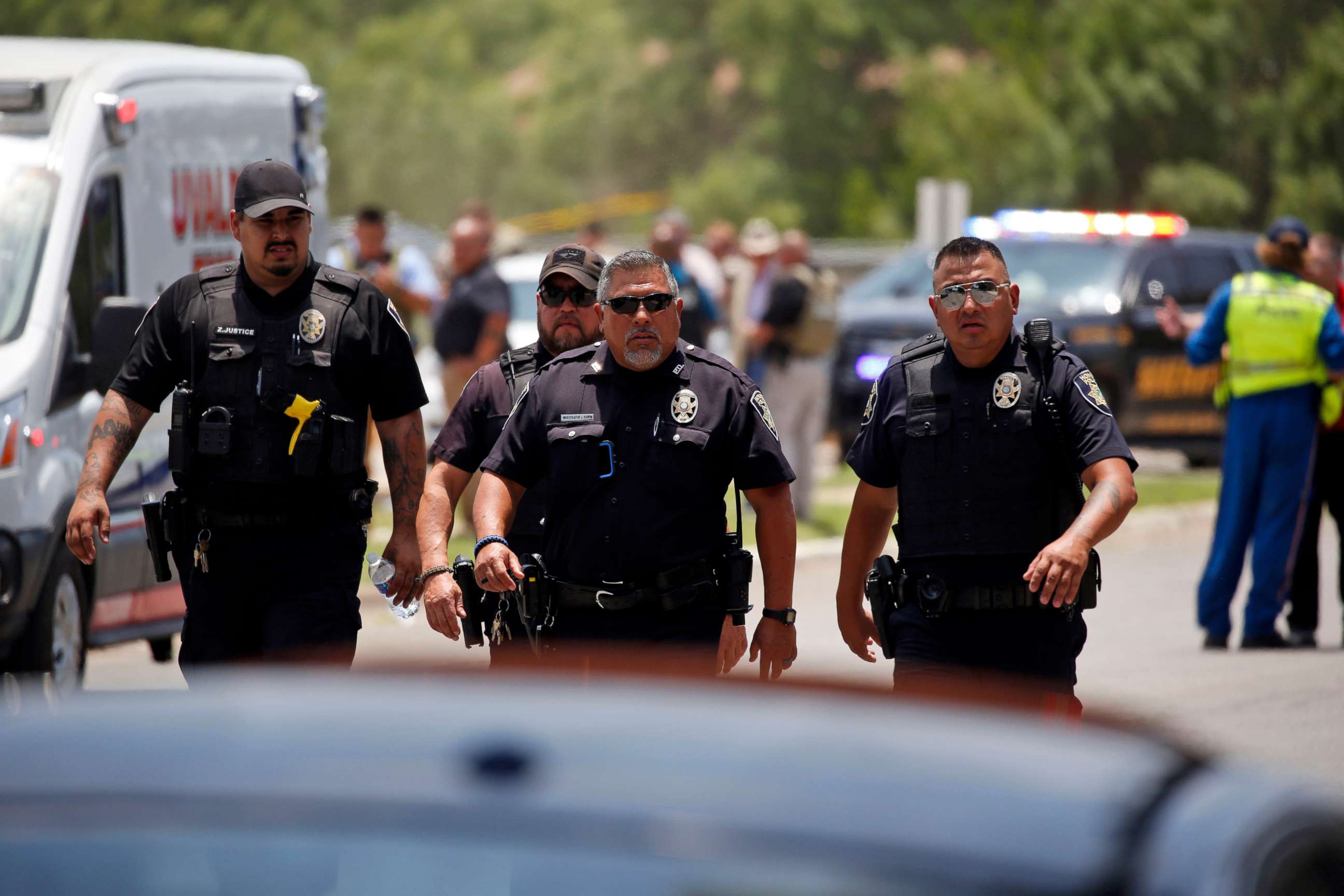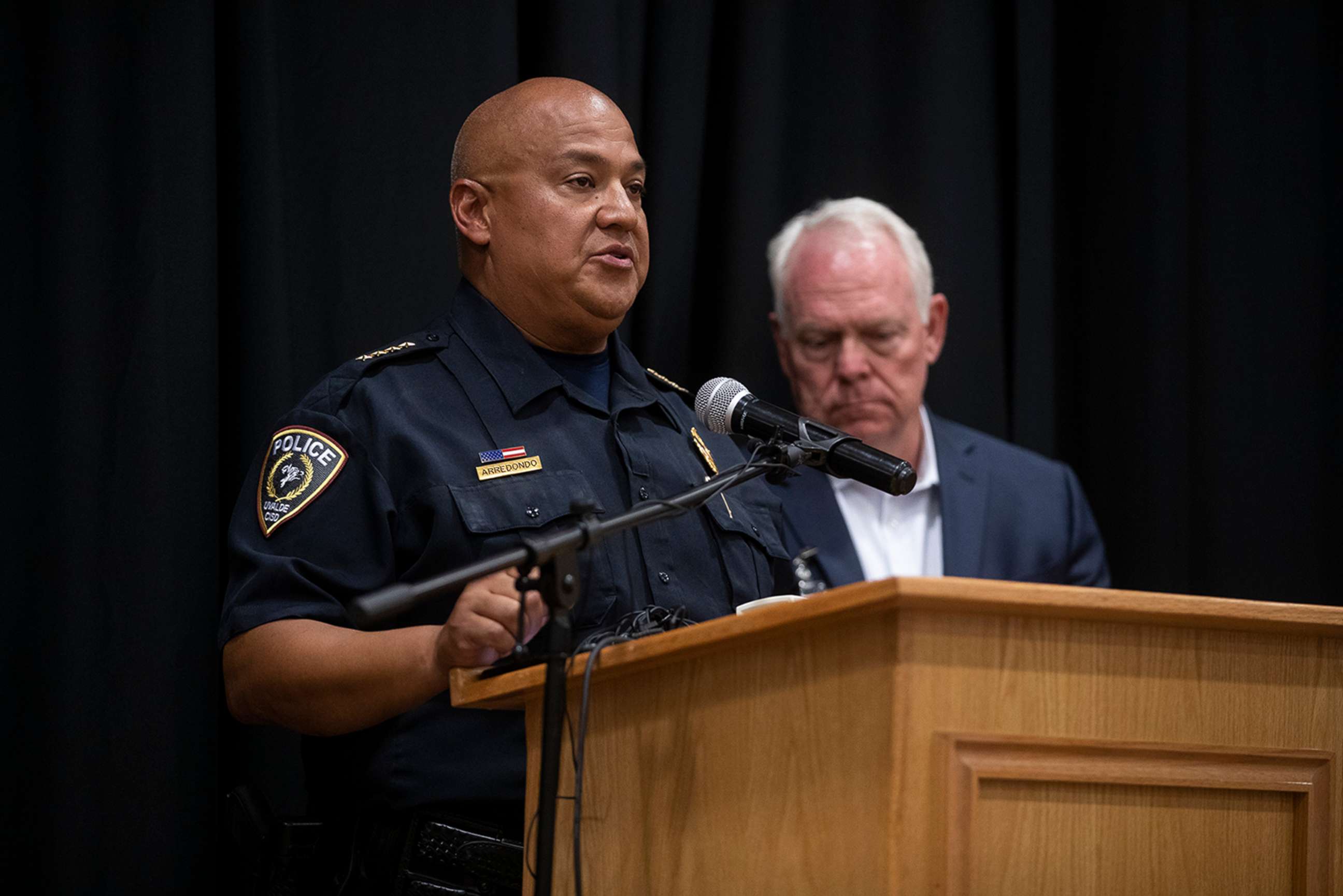1 month after the Uvalde shooting, here are 5 questions that are still unanswered
A local investigative panel is set to convene on Tuesday.
Nearly a month after a gunman killed 19 students and two teachers inside Robb Elementary School, shattering a West Texas community, a litany of key questions about the police response remain unanswered -- and some experts say the shifting narrative from state and local leaders in the massacre's aftermath could threaten to exacerbate the trauma for those affected.
"These types of tragedies can tear communities apart," said John Cohen, a former senior Homeland Security official who is now an ABC News contributor. "One of the ways the healing process can begin is for the community to have a clear understanding of what happened, and of what will be done to prevent something similar from happening again."
As families of the victims lay their loved ones to rest, residents of Uvalde continue to hope for answers. They may start to get some on Tuesday, when a Texas House panel convenes to hear testimony regarding the shooting.
Here are five questions that remain unanswered:
1) Was the door to the classroom locked?
Since the very first days after the attack, law enforcement officials have said their response was stymied by the very measure enacted to keep children safe during an active shooter event: a locked door. Officials have said that the gunman entered into the classroom and immediately locked the door behind him, keeping officers outside of the room while they waited for backup, supplies, and a key that could open the "hardened" door that was unable to be kicked in.
The gunman was left inside the classroom for 77 minutes as 19 officers waited in the hallway -- and many more waited outside the building -- after the incident commander wrongly believed the situation had transitioned from an active shooter to a barricaded subject, law enforcement has said.
The incident commander, Uvalde School District Police Chief Pete Arredondo, said in an interview that he waited in the hallway as a janitor brought dozens of keys, which he tried on an adjacent classroom door in search of a master key -- but none worked. Eventually a working one came.
But now surveillance video shows that police never tried to open the door to the classroom the gunman was in, according to a report from the San Antonio Express News that has been confirmed by sources to ABC News, although ABC News did not review the footage. While the classroom doors at the school are designed to lock automatically when they close, according to the report, new evidence suggests that the door may have been unlocked the entire time, despite the police assuming it was locked.
Officers in the hallway also had access to a "crowbar-like tool" which could have opened the door regardless of whether it was locked or not, the report said.
2) Did an active shooter alert reach the Robb community?
In recent decades, with mass shootings on the rise and advances being made in technology, school administrators and law enforcement across the country have scrambled to put in place safety protocols meant to alert staff and students in real time to a possible threat.
At Robb Elementary, shortly before the gunman entered the building on the day of the shooting, a teacher used their smart phone to trigger an alert through the school's emergency response app -- called Raptor -- according to the company that makes the alert system.
But whether the alert successfully reached the Robb community remains unclear. Arnulfo Reyes, a teacher inside one of the classrooms attacked by the gunman, said sometimes his Raptor app pings with alerts about nearby incidents -- but that no alert came on the day of the attack.

"You could hear the gunshots, but there was no announcement," Reyes told ABC News in an exclusive interview this month. "I didn't get anything, and I didn't hear anything."
At 11:43 a.m. -- ten minutes after the rampage began -- Robb Elementary School posted to Facebook that the campus had gone under lockdown "due to gunshots in the area."
3) Were officers informed of the 911 calls coming from children inside the classroom?
While officers waited outside of the classroom for 77 minutes, children who were still alive inside the adjoining classrooms the gunman had attacked were repeatedly calling 911 pleading for help, officials have said. There were multiple 911 calls made from children inside, officials have said, including one plea to "please send police now."
Texas Department of Public Safety Director Steven McCraw said it appeared that information may not have been relayed to officers on the ground, and Arredondo said in an interview that he was not aware of 911 calls while he waited in the hallway outside the classroom because he did not have his radio -- which he said he intentionally left behind because he thought it would slow him down.
"That question will be answered," McCraw said in the days after the shooting when asked directly if the incident commander on the ground received the 911 information. "I'm not going to share the information we have right now. Because I don't have -- I don't have the detailed interview right now."
Video obtained by ABC News last month taken outside Robb Elementary School as the massacre was unfolding appeared to capture a 911 dispatcher alerting officers on scene of 911 calls they had received from children inside the classroom.
4) Were responding officers appropriately trained?
Seventy-seven minutes passed from the time the gunman entered Robb Elementary until officers breached the classroom and ended his deadly siege. Law enforcement officials have since faced intense scrutiny for their failure to act faster, prompting questions about their level of preparedness.
Two months before the mass shooting, the Uvalde school district hosted an all-day training session for local police and other school-based law enforcement officers that was focused on "active shooter response." But basic training protocols -- including those involving communication channels and chain of command -- went unheeded, law enforcement officials later said. A failure to secure important equipment, including shields and high-powered weapons, may have also contributed to delays.
Eventually, officers on the scene used a key retrieved from a janitor to unlock the door to the classroom where the gunman had barricaded himself. Cohen, the former Homeland Security official, said the fact that officers had to resort to such a simple method of breaching the classroom after such a long period of time reflects poorly on the officers' planning.
"When developing an emergency response plan, it is deeply troubling that basic equipment -- such as keys or other breaching devices -- seemed to be unavailable," Cohen said.
5) Are law enforcement officials cooperating with the investigation?
As the probes into the police response continue, questions have arisen about whether or not Arredondo -- who has emerged as a key figure in the police response -- is cooperating.
Texas House Committee chair Dustin Burrows said on Friday that Arredondo had not yet agreed to testify before the committee, but on Monday he said that all law enforcement agencies have been cooperating.

"The Uvalde Police Department has been cooperative," said Burrows. Regarding Tuesday's hearing, he said, "We're going to hear from another officer with the Uvalde ISD [school district]. We're going to hear from a member of the Department of Public Safety on the ground."
"I want to at least compliment all the law enforcement agencies for being cooperative and providing witnesses that we have asked for," Burrows said.
On May 31, in the immediate aftermath of the shooting, The Texas Department of Public Safety said that Arredondo had not responded "for days to a request for a follow up interview" as part of that agency's investigation into police response to the massacre.
Arredondo's attorney disputed that characterization, telling the Texas Tribune that Arredondo had participated in multiple interviews with DPS in the days following the shooting, but could not come in for another interview when they requested because he was covering shifts for other officers.
"At no time did he communicate his unwillingness to cooperate with the investigation," Hyde said in the interview with the Texas Tribune. "His phone was flooded with calls and messages from numbers he didn't recognize, and it's possible he missed calls from DPS, but still maintained daily interaction by phone with DPS assisting with logistics as requested."



